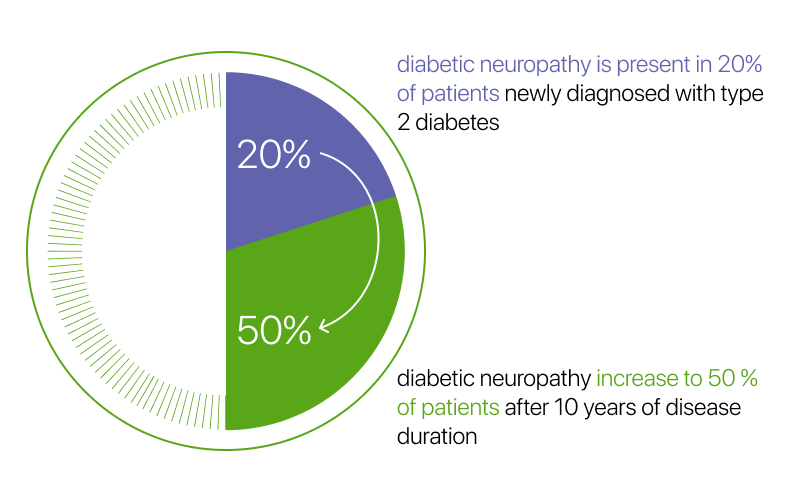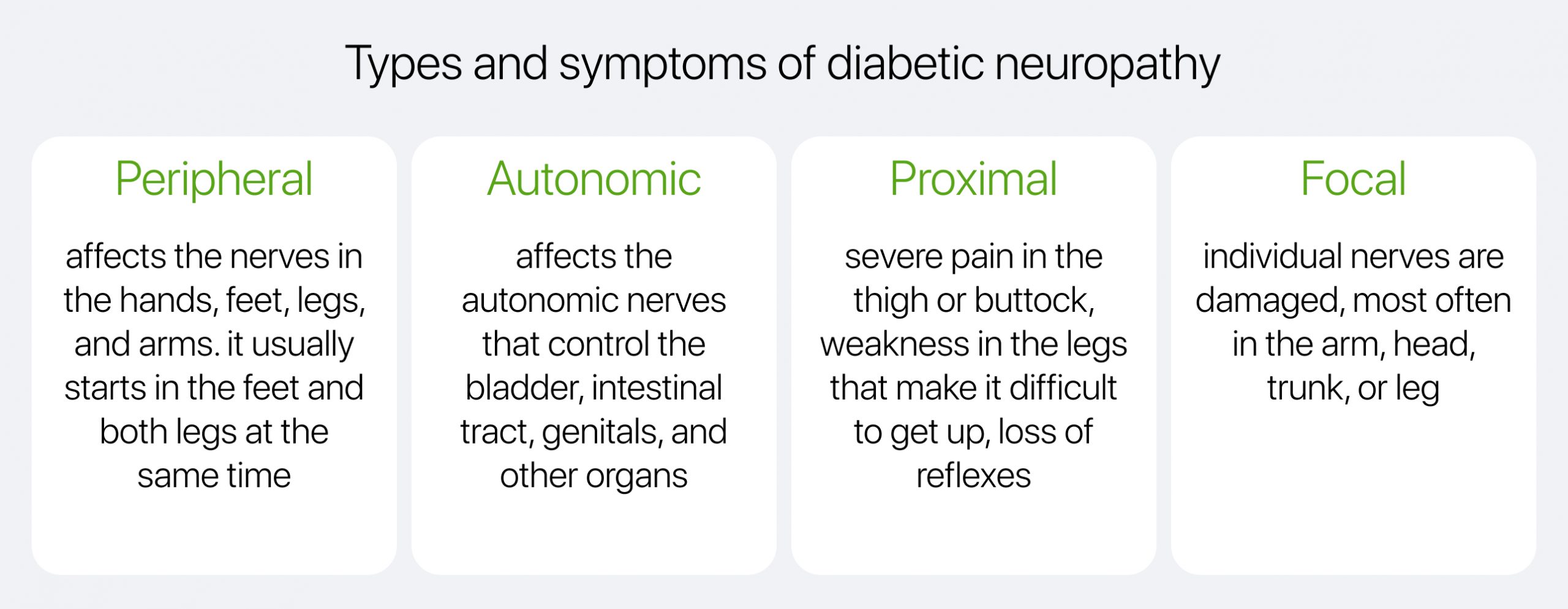Diabetic neuropathy pain treatment using compound medicines

Diabetes is a chronic disease in which the pancreas does not produce enough insulin. This disease is common, and diabetes remains one of the most pressing problems in medical and social society because it is one of the causes of premature morbidity and mortality. Very often people with this diagnosis have complications and health risks that can lead to loss of vision, kidney and heart failure, and amputation of limbs.
According to the American Diabetes Association, 37 million people in the United States suffer from diabetes. Just imagine, that is every 10th person in the country, and moreover, every 5th person does not even know that he or she has diabetes.
What causes diabetic neuropathy pain
If a person has diabetes, then she or he should understand the symptoms and complications. Diabetic neuropathy is one of the complications that cause nerve damage throughout the human body.
What causes diabetic neuropathy? High blood glucose levels and high levels of fats such as triglycerides in the blood from diabetes damage a person’s nerves. High blood glucose damages the small blood vessels that supply oxygen and nutrients to the nerves, so without enough oxygen and nutrients, the nerves cannot function well.
If we consider the statistics on diabetic neuropathy, according to ADA Surveillance, diabetic neuropathy is present in 15-20% of patients newly diagnosed with type 2 diabetes, and rates of diabetic neuropathy increase to 50 % of patients after 10 years of disease duration.


Let’s look at types of diabetic neuropathy, what can be the consequences of ignoring this disease, and what types of effective treatments are available
The first are sensory neurons. They transmit signals from the body to the brain and are activated by sensory signals from the environment. For a better understanding, here is an example: a person touches something hot and does not feel that it burns – it is a sign of sensory neuronal damage.
There are also autonomic neurons that control the work of internal organs and regulate the involuntary processes of heartbeat and breathing when signals are transmitted from the brain to the body.
The last one is motor neurons, which control movements and are rarely affected, but there are cases.
Types and symptoms of diabetic neuropathy
Peripheral is the most common type of neuropathy that affects the nerves in the hands, feet, legs, and arms. It usually starts in the feet and both legs at the same time. People complain of tingling and “goosebumps” on their feet, sometimes they feel as if they are wearing gloves or socks, although they are not. Patients can also feel pain and have hypersensitivity, and the slightest touch can cause unbearable pain.
The second type is autonomic neuropathy, which affects the autonomic nerves that control the bladder, intestinal tract, genitals, and other organs. The most common symptom is bladder paralysis when the bladder nerves stop responding to pressure when the bladder fills with urine. As a result, urine is retained in the bladder and this becomes a consequence of urinary tract infections. Also, people complain about the digestive system, they may be nauseated and vomit undigested food, or someone has diarrhea, or constipation, which makes it challenging to predict blood sugar levels. It can be a sudden loss of consciousness, dizziness, or increased sweating, all symptoms manifest differently.


Proximal neuropathy is a rare type of nerve damage in the thigh or buttocks. It occurs more in men than in women over the age of 50. Symptoms include sudden and sometimes severe pain in the thigh or buttock, weakness in the legs that make it difficult to get up from a sitting position, loss of reflexes, muscle tissue, weight, and muscle wasting.
Focal neuropathy is a condition where individual nerves are damaged, most often in the arm, head, trunk, or leg. People have entrapment syndromes, where nerves are in places where they pass through narrow passages between bones and tissues. For example, carpal tunnel syndrome causes pain, numbness, tingling in the thumb, index, and middle fingers, and sometimes weakness of the grip.
All of these symptoms that manifest in the body are distasteful, so treatment is an important component, people who suffer from neuropathy pain should always be examined and keep in touch with the doctor because ignoring can lead to even worse consequences.
In the worst case, ignoring treatment can lead to amputation, because the nerves will no longer be able to function properly. The person will become disabled and will not be able to live their life fullest, so treatment should be taken responsibly.
What are the risk factors for diabetic neuropathy pain? These are smoking, high blood sugar and high triglycerides, being overweight, and high blood pressure.
We will describe what steps we can take to prevent or slow down nerve damage. If we consider what we have listed above, then a person must change their life habits.
Reduce alcohol consumption, stop smoking, increase daily physical activity, meal planning, and medication control. One of the most important is to keep blood sugar levels within the range. We can use a glucometer and take a laboratory test for HbA1c twice a year to find out the average blood sugar level in recent months – this is an important thing to do because it will show you and your doctor whether the treatment plan is working if not, it needs to be changed.
Also, what is equally important is foot care. Comprehensive foot evaluation at each follow-up visit or at least once a year; Daily checks at home for sores, cuts, or breaks in skin; Protect feet, avoid walking barefoot, and wear comfortable shoes.
Remember this key point, early treatment can help to prevent more problems in the future, so you must not ignore this neuropathy pain, keep in touch with your doctor in case of worsening symptoms, and take care of your health, taking into account the tips we have listed, you can really prevent the worst.
Diabetic neuropathy treatment and pain management
Despite years of research and advances in medicine, there are no cures for diabetic neuropathy, but pain management treatment is available to improve quality of life.
For effective pain management, components must be chosen depending on the specific condition. To select an effective treatment for the patient, we must know the exact cause of the problem, medical history, individual characteristics, allergic reactions, known drug tolerances and interactions with currently used medicines, etc.
For many patients, Mega Aid Compounding Pharmacy can provide improved outcomes through customized and targeted medications for diabetic neuropathy treatment paired with a program of monitoring compliance and outcomes using Mega Aid Compounding Pharmacy’s in-house end-to-end digital medication therapy management system.
Mega Aid Compounding Pharmacy creates medications that are unavailable on the mass market. Tailored treatment is selected for each patient regarding specific health conditions to improve symptoms in the most effective way.
Mega Aid Compounding Pharmacy uses USP-quality chemical ingredients and complies with the highest standards of dispensing, mixing, packaging & storage of the compounds.
Three keys that describe Mega Aid Compounding medications:
If you are a healthcare provider and you want to improve patient outcomes with Mega Aid, contact us to connect with a dedicated Pharmacy Liaison who can discuss our formulation capabilities that are appropriate to each patient’s individualized condition and needs.
The first class of drugs is the Gabapentinoids, which are pregabalin and gabapentin. They work by inhibiting excitatory neurotransmitters: glutamate, substance P, and CGRP.
The next class of drugs is Antidepressants, which include Duloxetine, and Venlafaxine (SNRIs); Amitriptyline (TCA). These treatment work by decreasing the perception of pain by blocking the reuptake of serotonin and norepinephrine.
There is one topical drug that is approved for the treatment of diabetic neuropathy and it is Capsaicin. Capsaicin is derived from Chili Peppers and is available at variable strengths and preparations from 0.075% – 0.1% topicals and 8% patches. The function of Capsaicin is that it works on the TRPV1 receptor causing nociceptor defunctionalization and depletion of substance P, which is one of those neurotransmitters necessary for pain. This functionalization means they overstimulate that receptor to a point that it doesn’t transmit anymore, simply it desensitizing the area, so the patient no longer feels pain.
Mega Aid Compounding Pharmacy encourages a multi-modal treatment approach with the ability to make multiple formulation combinations in each therapeutic class. We have experience preparing highly-targeted topical compound medications containing a combination of active ingredients including lidocaine, capsaicin, gabapentin, doxepin, and diclofenac in varying concentrations.
Patient therapy compliance using medication therapy management
It often happens that patients can be non-compliant with their treatment or they are capable of forgetting to take their medicines properly and monitor all the symptoms during treatment. Also, patients may not inform the healthcare provider about other prescribed drugs, allergies, side effects, and other factors that could impact on effectiveness and safety of treatment. This could lead to health complications and the absence of treatment effects.
The benefits of the medication therapy management program conducted by Mega Aid Compounding Pharmacy are:



